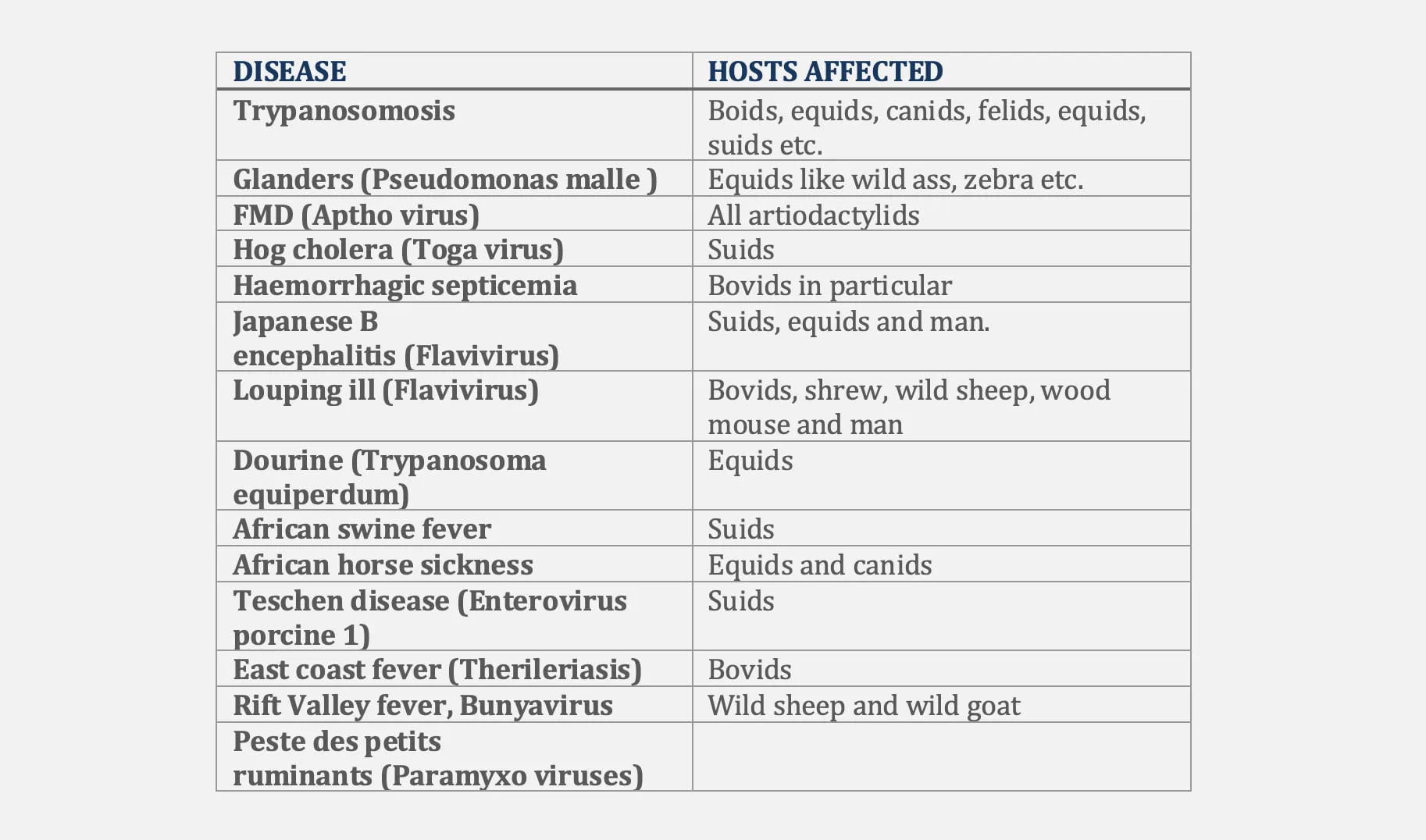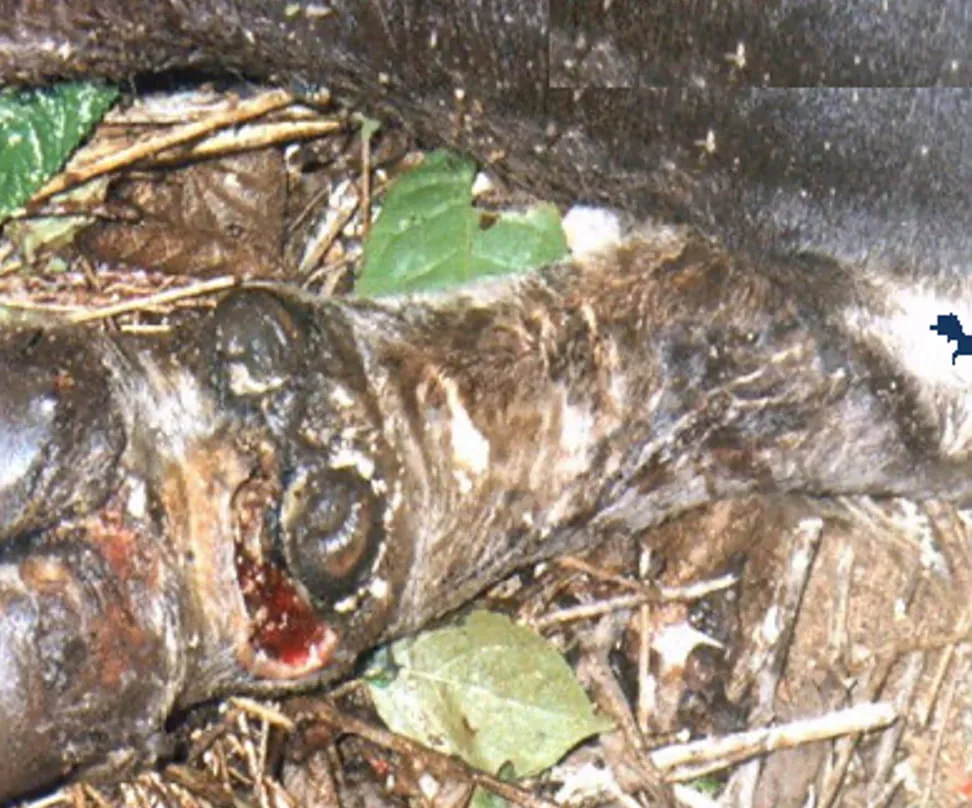TABLE OF CONTENTS
Infectious Diseases in Wild Animals
Infectious diseases in wild animals have to be understood well by the veterinarians. These are the significant causal agents for the ongoing morbidity and mortality among various captive and free ranging wild animal species, in various regions of this world.
Proper identification of various agents associated with this should be known and their pathogenic potentials for other animals or for man have to be given significance always.
PCR plays a major part in effecting the proper diagnosis of the various infectious agents in general. However, conventional techniques also assume significance for the proper understanding of these diseases affecting wild fauna.
Significant infectious diseases affecting should be known.

Viral Diseases
Viral diseases causing problems to the routine performance of the wild animals are caused substantially by many viral agents also.
In both the captive and free ranging wildlife regions, the diseases caused by different viral agents are being documented through out the world.
However, the research findings are still to be improved in this regard due to various reasons.
FMD
- FMD disease occurs in case of wild ruminants and other artiodactylids, in general. Affected wild animal species may have lesions in the foot and mouth.
- This disease may lead to severe morbidity among the hooved stock.
- This disease has been documented in herbivores like gaurs, cervids, suids etc. and is common among wild fauna but needs documentation in most of the cases.
- Elephants are also affected.

Rabies
- Rabies has been documented in chital, rhino, elephants etc. Even oral infection has been documented in foxes and skunks by experimental means, following the ingestion of mouse carcasses infected by rabies virus.
- It is noteworthy to mention that the exposure to rabies virus in peripheral nerves could potentially occur when a person with wounds on the hands does not wear any protective covering or gloves while skinning rabies suspected captive wild animal.
Measles (Rubeola), Viral Hepatitis, Kyasanur Forest Disease (KFD) and Others
- Measles is one of the most frequently reported viral diseases of non human primates and upon infection, the virus is shed and can re-infect man.
- This is a highly infectious exanthematous viral disease of children. This has been documented in marmosets, tamarins, owl monkeys etc. and is fatal to them.
- Several outbreaks of viral hepatitis have been documented in primate handlers and primate practitioners.
- The virus causing human infectious hepatitis (hepatitis A) can infect chimpanzees, patas, wooley monkey, gorilla, tamarins, cebus etc.
- KFD has been reported in non human primates and is of zoonotic importance.
Herpes Virus and Pox Virus Infections
- Herpes virus infections are documented in non-human primates, elephant calves etc. In man, herpes B virus can be fatal, causing an acute ascending myelitis.
- Rhesus macaques and cyanomolgus are considered as the primary natural hosts.
- Lesions in non-human primates are mostly confined to the mucosa of buccal cavity.
- Ulcers or vesicles do occur around the lips and external nares and the most common site is the tongue. Monkey bites and laboratory accidents lead to the most human infections.
- Pox virus infections often are classified into four types in non-human primates, elephants etc. All these four diseases are infectious to man but it is to be remembered that the monkey pox is the most frequent one.
- Pox virus was documented in chimpanzee under captive condition reared at zoological garden.
Respiratory Infections
- These are common in case of felids. Feline viral rhinotracheitis is the most common of the diseases that affect the felid group.
- Transmission is through the saliva and respiratory secretions contaminating the feed resources.
- Incubation period of this viral infections is two to four days. In case of calci viral infections of felids, it is one to two days.
- Symptoms comprise the weight loss, signs of dehydration, anorexia, fever and salivation along with sneezing and reluctance to drink.
Canine Distemper
- This is a viral disease affecting the canids as well as the felids.
- The occurrence of canine distemper in case of felids as an outbreak has been documented among the free ranging lions in Africa.
- Affected ones reveal dullness, ataxia or deranged gait, anorexia, thick muco-purulent discharge etc. in general.
Haemochromatosis and Amyloidosis in Captive Birds
- In aviary species, abnormal accumulation of iron mainly in liver, with lesser amounts in heart, kidney and pancreas occurs (mynahs are most commonly affected by this metabolic disease condition) and there is no specific therapy.
- Deposits of shapeless material in liver, spleen, adrenal and renal tissues occur in amyloidosis and has been documented in case of aquatic birds like swans, flamingos and ducks. Older birds are specifically affected by this condition.
Parasitic Diseases
Natural areas in tropical and sub tropical climates are more likely to enhance development of parasitic loads because of the fact that there are variations in climates of these areas in addition to the variations in the type of vegetations and species of wild fauna.
The parasitic diseases have caused serious problems in captive animals and it is to be accepted that some of the diseases bear Zoonotic significance.
Hence, treatment and prevention against parasites gain significance always in the wild animal health and disease management.
In non-human primates, the following parasites are more commonly encountered, i.e. Strongyles, Strongyloides spp, Trichuris spp, Entamoeba spp and Balantidium spp are zoonotically important ones.
In carnivores, especially in felids, the parasites are numerous leading to harmful features to different systems in the body and depending on the load and pathogenesis, animals suffer, in general. The common internal parasites in felids are Toxocara cati, Ancylostoma spp, Taenia spp, Dirofilaria immitis, Spirocerca lupi and the common blood protozoa parasites that are often encountered comprise Trypanasoma evansi, Toxoplasma gondii and Hepatozoa spp. Similarly, fleas like Ctenocephalides spp and the ticks are also more common.
The trematodes like Fasciola hepatica and Fasciola jacksoni have been reported in Asian elephants, where as Protofasciola robusta was reported in African elephants. There are numerous nematode parasites in the elephant like ascarids, oxyurids, strongylids, paraphistomes, ancylostomes, syngamids and filarids. Cestodes like Anoplocephala manubriutaare also reported. The protozoan disease like Trypanosomosis is a serious problem in Asian elephant caused by Trypanasoma evansi. Flea and tick infestations are more common in elephants. Amblyomma tholloni ticks (elephant tick) are found through out the body. Haematomyzus elephantis (elephant louse ) are generally found in the base of the tail and behind the ears.
Internal parasitres are more common in wild ruminatnts also. The common parasites are Haemonchus spp, Ostertagia spp, Trichostrongylus sp, Oesophagostomum spp, Strongyloides spp, Trichuris spp, Taenia spp, Ascaris spp, Eimeria spp, Fasciola spp, and protozoan diseases like Babesia spp, Theileria spp, Trypanasoma spp etc are more common in wild ruminants. External parasites mange and tick ingestion are also common. Psoroptes spp, Sarcoptes spp and demodex spp are caused mange infestation in wild ruminants.
In case of reptiles like snakes, tick infestation is more common. The common ticks are Aponomma sp, Amblyomma spp, and Hyalomma spp. Internal parasites like Capillaria spp, Rhaddius spp. Ophidascaris spp, Isospora spp, Eimeria spp, Kalicephalus spp, Polydephis spp are similarly encountered in them.

